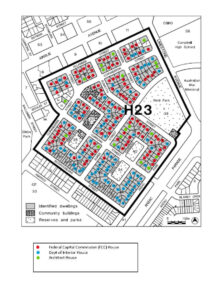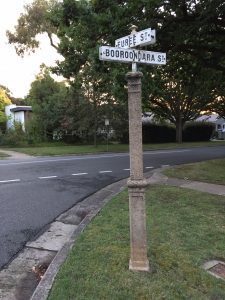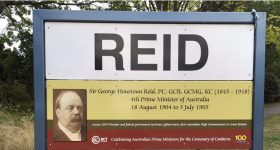Welcome to Reid, our marvellous suburb in Canberra, the national capital of Australia, in the Australian Capital Territory (ACT).
The city of Canberra has been built on what early settlers named the Limestone Plains. The Ngunnawal people are recognized as the traditional owners of the area which was previously an important meeting place for a number of Aboriginal groups including the Ngambri and the Ngambri-Guumaal.
Reid is situated on the flat land at the base of Mount Ainslie, is one of Canberra’s oldest suburbs and its largest heritage housing precinct.
Reid’s history and heritage of Reid make it unique in urban planning. Reid provided housing for government officials and so is directly linked to the establishment of the Parliament of Australia.


The uniformity of the dwellings – much of the form of the original housing stock (FCC & Department of Interior) is still recognisable even if, over time, alterations have been made.
Its wide streets and verges are lined with deciduous trees & evergreen trees, plantings guided by Thomas Weston, officer-in-charge of afforestation, Canberra.
Most of the suburb of Reid is heritage listed and it is situated in close proximity to many of Canberra’s iconic buildings such as the Australian War Memorial and St John the Baptist Anglican Church.
Reid is within easy walking distance from Canberra’s CBD and the suburb has many amenities including a tennis club, sports oval, churches, memorials, a preschool, Reid CIT, parks and is close to the Canbera Olympic Pool, Civic.
History
Reid is named after Sir George Houstoun Reid, Australia’s 4th prime minister and was gazetted as a suburb on 20 September 1928.
Construction of Reid commenced in 1926. The Parliament of the Commonwealth of Australia had been meeting in Melbourne, Victoria, and was relocating to the new national capital, Canberra. There was an urgent need to transfer government officials to Canberra as the provisional Parliament House – now known as Old Parliament House – was scheduled to open in 1927. Public servants required accommodation and so the construction of the suburbs of Braddon, Barton, Forrest, Yarralumla, Ainslie and Reid was undertaken.
Reid was planned on Garden City and American Beautiful principles. These principles aimed to create healthy working and living environments for urban residents and were integral to Walter Burley and Marion Mahony Griffin’s winning design for Canberra, the new Federal Capital of Australia
Click for a timeline of Reid’s history.
Street names
 Street names in Reid are representative of all the principal Aboriginal languages and were selected in alphabetical order, radiating outwards from London Circuit.
Street names in Reid are representative of all the principal Aboriginal languages and were selected in alphabetical order, radiating outwards from London Circuit.
| Allambee | Recline or rest |
| Amaroo | Beautiful place |
| Boolee | Star |
| Booroondara | Shady place |
| Cooyong | Bandicoot |
| Coranderrk | Christmas bush |
| Currong | Silver wattle |
| Dirrawan | Emu |
| Doonkuna | Rising ground |
| Elimatta | My home |
| Euree | Sleep |
| Gooreen | Wind |
| Kogarah | Place of rushes |
Further Information:
- ACT Archives
- ACT Place Search
- Discovering Milldenhall’s Canberra. The photographs of early Canberra taken by William (Jack) Mildenhall chronicle the construction of Canberra including Reid.
| Books | ||
| Author | Title | Published |
| Reid Residents Association (Shibu Dutta) | The Heritage of Reid | Canberra 2000 |
| R T Winch | The Red Bricks of Reid – Canberra’s First Urban Church | 1977 |
| Peter Freeman | The Early Canberra House – Living in Canberra 1911-1933 | 1996 |
| National Trust of Australia
Ken Charlton, Rodney Garnett, Shibu Dutta |
Federal Capital Architecture Canberra 1911-1939 | 1984 |
| Mary Machem | Pictorial History of Canberra | 2000 |
| Steve Parish | Canberra ACT Capturing the Spirit of Australia’s National Capital | |
| Edwards A.H. | Street Trees in Canberra, ANU Press, Canberra | 1979 |
| Rolland W.M. | Growing Up in Early Canberra: birth place of a capital city, Kangaroo Press, Kenthurst | 1988 |
| Wilson, R. & Garnett, R. | Sanctuary in the City, St John’s Church, Canberra, Anglican Church of St John the Baptist, Canberra | 2012 |
| Body A.H. | Firm still You Stand The Anglican Church of St John the Baptist, Canberra, Its Parish & Parishioners 1841–1984, St John’s Parish Council | 1986 |


